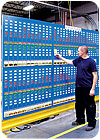
It seems fitting that our company, Lista International Corp., which provides storage and workplace solutions for business and industry, and whose motto is “making workspace work,” should embark on an innovative lean manufacturing program to drive waste out of its own manufacturing processes. And it is even more fitting that we would use our own products to help make the move to lean a successful one.
An ISO 9001-certified company, we were founded in 1968 and are based in Holliston, MA. The corporate headquarters houses a 225,000-square-foot manufacturing facility, as well as design and engineering offices. Lista North America is part of Swiss-based Lista Group, which manufactures modular drawer storage systems, workbenches and storage solutions, and employs more than 600 people worldwide.
We began our lean program about four years ago with a simple goal: provide customers high-quality, custom-configured products with the shortest turnaround time in the industry. The first step, done quickly, was improving material flow and process flow. However, within the last year, we have steadily reduced our turnaround time from more than two weeks to as little as two to four business days for many popular products.
Along the way, we have moved work centers close together, eliminated travel in the process line and significantly eliminated waste throughout our delivery system. We have reduced our inventory by more than 35 percent, while reducing lead times and improving customer service. Overall, we have increased productivity and efficiency, and reduced our requirements for floor space.
We made fundamental changes in the order and delivery system and the manner in which we drive customer orders through our production process with demand replenishment concepts and principles. Lean manufacturing allows us to extend our capabilities-to expand what we can provide to customers in the shortest lead time possible.
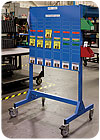
A mobile kanban board helps workers analyze the manufacturing process to
prevent overstock of inventory. Photo courtesy Lista
International Corp.
Lean Manufacturing Toolkit
Lean manufacturing uses a set of tools that assist in the identification and steady elimination of waste. Among the ones we use are value stream mapping, the 5S workplace organization and housekeeping system (sort, set in place, shine, standardize, sustain), and a kanban order and inventory withdrawal system. We integrated our own product line to help implement the results of these tools.“When you think about it, it’s like the reverse of the old saying that the cobbler’s children have no shoes,” says John Grover, director of lean manufacturing. “In our case, as an industrial storage company, we had access to a product line that helped us implement waste elimination through space reduction, organization improvement and inventory management.”
Our lean manufacturing system is set up so everything has a place that is available when needed, from the finished goods area where products are being packaged, through the equipment maintenance area. Everything is labeled and identified for increased flexibility. Local storage minimizes travel time, and adjustable storage and workbenches make it easier to adapt to the differing needs of individual employees.
“We are always looking internally to reduce non-value added process and movement time,” says Aaron Tessitore, director of operations.
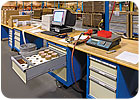
The factory floor contains many shipping benches. Photo
courtesy Lista International Corp.
Customer Benefits
Although lean manufacturing is sometimes thought of as the ultimate cost-cutting program, our program focused more on customer benefits. “All the work we did in our program took aim at compressing the cycle time, which gives our customers added flexibility and minimizes the lead time for our product line,” says Tessitore.We now offer an improved Xpress delivery program-one that lets us deliver a product that is exactly what the customer wants, not just “pretty much” what the customer wants. Previously, because Xpress program products were pre-built and stocked in a warehouse, it was not possible to change anything about an Xpress product to respond to a specific need.
In addition, lean manufacturing has improved the quality of our products. Fewer components are being made on a job-by-job basis and dealt with during final assembly, significantly reducing the potential for short shipments or mistakes.
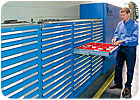
The factory tool crib cabinet provides safe and efficient storage of
perishable tools. Photo courtesy Lista International Corp.
Value Stream Mapping
We used value stream mapping to analyze the material, process and information flow used to drive customer requirements and satisfaction goals across the organization. The information was used to develop a current state map, which set out how things were done. Then, a cross-functional team analyzed the current state map to identify opportunities for waste elimination. Finally, the team envisioned a future state based on the exercise.Employees at all levels were deeply involved in the value stream mapping and remain involved in the implementation.
Implementing the future state is an iterative process. In essence, the future state becomes the current state, and we continuously identify new ways to reduce waste. Waste includes things like the movement of material, amount of inventory carried, defects or rework and producing scrap.
One concrete outcome of this exercise was the elimination of our 17,000-square-foot finished goods inventory warehouse. Since moving towards a build-to-order Xpress system, we no longer need to stock finished goods.
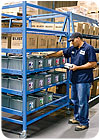
The mobile gravity feed flow rack uses gravity
to deliver parts, components and cartons for picking, kitting or assembly in
material-handling applications. Photo courtesy
Lista International Corp.
Kanban Reduces Overstock
Kanban is an inventory replenishment system for just-in-time production. After a careful analysis of our manufacturing process, we determined that fabrication of steel parts prior to being powder coated took the greatest amount of time. So now, rather than basing manufacturing on customer orders, we are directed by usage models, which ensure that just enough stock is ready to paint and assemble to fulfill customer orders. This means we no longer have to keep finished goods inventory in stock, but always have material ready to paint and assemble to order.Our kanban system uses a visual board set up with all the parts listed for a particular work center. All manufacturing activities are the result of a visual-based demand replenishment system. Operators see how fast the parts they manufacture are being consumed and can react quickly and decisively to ensure customer requirements are met.
The system streamlines production for our high-volume, repetitive-demand products, which are primarily our workbenches and cabinets. These products account for 80 percent to 85 percent of our output.
Equally important, the system empowers employees and allows them to fulfill needs in real time, rather than making products in a sequence that is based on paper-intensive material requirements planning documents.
“It’s a shift in a way of looking at the process,” says Grover. “This is what is meant by lean-not just eliminating waste in the process, but doing things that are required to add value to the customers, at the lowest cost point in the process and earliest phases. Lean manufacturing pulls all these pieces together, giving you the toolkit, mindset and the methodology to keep working at a continuous improvement process in an extremely effective manner.”
ASSEMBLY ONLINE
For more information on workstations, read these articles: